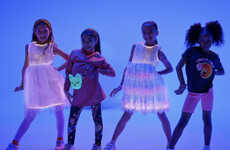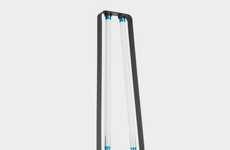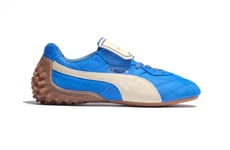
Fashion Spy — December 7, 2006 — Fashion
We've seen a couple examples of fiber optic fashion. The tops shown here are made by LumiGram and they use fiber optic fabric to illuminate at night. I'm sure these will hit the rave scene in no time at all.
Implications - The shirts function through the use of plastic optical fibers that are woven alongside synthetic fibers. The resulting fabric can be sewn and hand washed as normal, but also has the remarkable ability to light up in a brilliant display. The electronic module component of the fabric can be fueled either by batteries or a small transformer. This is definitely some seriously exciting fashion, so let's hope it becomes increasingly popular in years to come.
Implications - The shirts function through the use of plastic optical fibers that are woven alongside synthetic fibers. The resulting fabric can be sewn and hand washed as normal, but also has the remarkable ability to light up in a brilliant display. The electronic module component of the fabric can be fueled either by batteries or a small transformer. This is definitely some seriously exciting fashion, so let's hope it becomes increasingly popular in years to come.
Trend Themes
1. Fiber-optic Clothing - Fiber optic fabric being weaved into clothing can pave the way for a new category of wearables that not only look good but also serve a practical purpose to enhance visibility and safety.
2. Smart Textiles - Incorporating technology into textiles can open doors for textiles with the capability of interacting with the environment, tracking heart rate, body temperature, and other physical indicators of the wearer.
3. Eco-friendly Textiles - Integrating sustainable practices into textile manufacturing could decrease the reliance on non-renewable materials and reduce waste in the fashion industry.
Industry Implications
1. Fashion - Incorporating fiber optic fabric in clothing could lead to a whole new category of wearable fashion design that lights up any situation and could take the rave scene by storm.
2. Technology - Combining technology with textiles can create applications beyond just clothing including automotive, medical, and entertainment industries.
3. Sustainability - The fashion industry has been one of the largest polluting industries. Adopting eco-friendly practices in textile manufacturing could reduce carbon footprint, water usage and energy consumption.
5.2
Score
Popularity
Activity
Freshness























